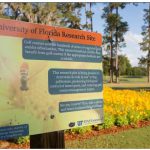Public Service Announcement:
YOU can help prevent “muhly mutilation!”
Every year, just as the fall muhly grass extravaganza is about to begin…
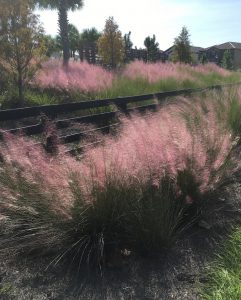
…an unfortunate (but fully preventable) horror-show occurs. And this one isn’t related to Halloween…
All across Florida, vibrant green tufts of muhly grass sway, lush and full after a summer of growth….

….until they’re chopped down in their prime! Transformed into living “boot brushes.”

Thanks to this late-season “chop,” these unfortunate ornamental grasses won’t be very “ornamental” this year. At best, they’ll push out a few scraggly feathers, but it will be nowhere near the gorgeous display that should have been possible…
Yes, sadly, instead of ethereal pink feathery clouds swaying in the fall breeze, backlit by the morning sun… certain landscapes across Florida will once again be plagued by the sudden appearance of stubby, bristly, brown lumps. If you squint, they bear an odd resemblance to hedgehogs crossed with plucked flamingos…
🙁
The problem?
To prevent “muhly mutilation,” it’s helpful to understand why it occurs.
It all goes back to… you guessed it…
Yes, many of these hacked grasses have something in common… They’re growing TOO LARGE for their space!
A healthy muhly grass, once fully established, can easily span upwards of 3’+ across. Often, the grasses that are getting chopped down in late summer were simply planted WAY too close to a curb, a walkway, a parking space, a doorway, etc. At first, that location might have worked just fine, but now that they’re thriving, they’ve begun to interfere with pedestrians, or prevent car doors from opening, etc.
The solution?
(HINT: Yes, it involves that “right plant, right place” thing…)
If your muhly has outgrown its space, and chopping has become your only option, promise me this – Before next year’s fall show, you’re going to make a pledge to dig up that muhly grass, and re-plant it in a better spot… one where it can reach its full potential. You might not even need to move it very far. Often, sliding it back a few feet from the curb or sidewalk is all that’s needed to bring harmony back to your intended landscape design…
Timing is everything…
The ideal time to do this move will be in late winter or early spring. (i.e. February/March if you’re here in central FL.) At that point, the grass should be preparing to emerge from winter dormancy with a fresh new flush of growth.
(TIP: If the clump has gotten especially large, you can also divide it at that time.)
So if you currently have a “boot brush” in your landscape, take the pledge to help end “muhly mutilation.” You’ll be rewarded with fantastic Florida-Friendly #FloridaFallColor.
NOTE: While you’re at it, look around for other similar issues. If you notice that a plant is constantly getting chopped up into an ugly, mangled mess, consider moving it to a space where it can achieve its full potential. Not only will the plant look better, you’ll also be saving money / time due to the reduction in pruning & cleanup!
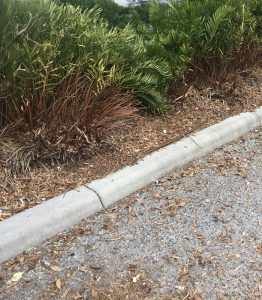

TIP: Love the look of muhly grass, but simply don’t have the space it needs? Try one of the native lovegrasses! Purple lovegrass and Elliott’s lovegrass can both add a splash of color and texture to your landscape, but in a much smaller package than muhly.
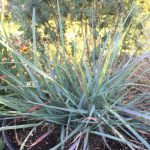
Getting excited for fall yet?
Ok, maybe it’s still feeling like a sauna outside… Go grab something “pumpkin spice” flavored and get excited for the changing seasons with this previous post about Florida Fall Color!
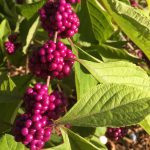

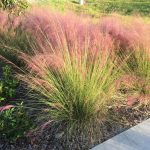

Speaking of “right plant, right place”…
THE PLANT SELECTION GUIDES!
Florida-Friendly Landscaping isn’t a single look or style. When you choose the plants that work best for your particular site conditions, it means less watering, less pruning, less fertilizing, and less spraying… and more enjoying!
Find the perfect plants to bring your ideal landscape to life. Check out these helpful interactive guides!
Waterwise Plant Selection Guide – This is a very user-friendly, searchable online plant selection guide from Saint Johns River Water Management District (SJRWMD). It includes both native & non-invasive “Florida-Friendly” options. The guide allows you to select plant type (i.e. groundcover, flower, ferns, trees, vines, etc.), soil conditions, salt tolerance, plant height, growth characteristics, flower color, etc. It includes photos for many plants. (Bonus – If you want to search for a plant by name, but aren’t sure exactly how to spell it, this guide includes a helpful “sounds-like” search option!)
Florida Native Plant Society (FNPS) Plant Selection Guide – This is a searchable plant selection guide specifically for Florida’s native plants. This guide allows you to search for specific plants by name, or to choose your range/county, select site characteristics, salt tolerance, etc. and generate a list of suitable plants for your site. Recently updated with improved navigation & new photos!
Florida-Friendly Landscaping Plant Selection Guide – This is the online version of the popular Florida-Friendly Landscaping Plant Selection Guide, and it has recently been updated too! Browse the entire plant list, or search for site-appropriate plants using a variety of filters. The database includes native & non-invasive “Florida-Friendly” options. (Also available as a FREE mobile app!)
Florida-Friendly Landscaping Butterfly Garden App – Plant lists, design and gardening tips, and butterfly guides are at your fingertips with the UF/IFAS Florida-Friendly Landscaping™ Program’s free Butterfly Gardens mobile web app.
Florida-Friendly Landscaping Bee Garden App – Florida is home to an amazing diversity of bees. This resource provides plant lists, design and gardening tips, and bee guides, right at your fingertips.
Florida-Friendly Landscaping FAQs – Find answers to the most common FFL-related questions.
“Work smarter, not harder!” = Right plant + right place + right care + right time
By Frank Galdo
About the Author:
As one of the Florida-Friendly Landscaping (FFL) Program Coordinators in Pasco County, my goal is to help show that vibrant, resilient landscapes DON’T require constant inputs of water, fertilizer, and pesticides. It’s all about “working smarter, not harder!”
Through an innovative collaboration with Pasco County Utilities, I also provide targeted on-site landscape & irrigation troubleshooting to help individuals and communities identified as high water users. My motto is – “Less guesswork, better landscapes.” I can be reached at fgaldo@ufl.edu
Thirsty for more FFL knowledge? Don’t forget to follow us on Facebook & Twitter!
Have a question, or an idea for a future post? Let me know at fgaldo@ufl.edu or leave a comment below.
About UF/IFAS Extension: UF/IFAS Extension serves as a source of non-biased, research-based information for the residents, businesses, and communities of Florida, providing educational materials and programs for adults and youth. We proudly “provide solutions for your life.”
(Not in Pasco County? Not a problem! Click here to find your local UF/IFAS Extension office!)
UF/IFAS Extension Is An Equal Opportunity Institution.
by Frank Galdo
 0
0

